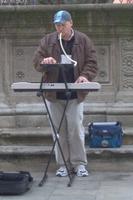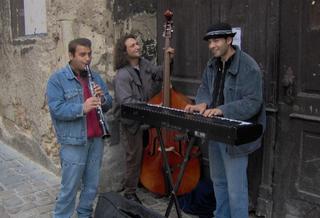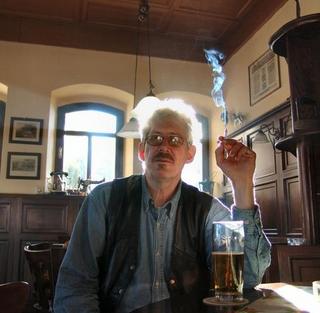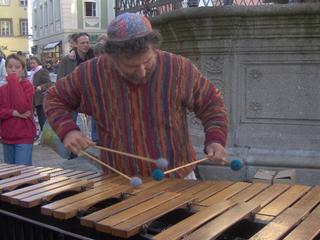More Street Music
 Regensburg is a great music venue. Every weekend it’s full of musicians playing for free—that is for whatever you put in their bowls. Some sell CD’s of their work , but contributions are their bread-and-butter.
Regensburg is a great music venue. Every weekend it’s full of musicians playing for free—that is for whatever you put in their bowls. Some sell CD’s of their work , but contributions are their bread-and-butter.
Some are classically trained artists, some are journeymen just learning how to collect a crowd, others are beggars with instruments. Some music comes floating down to the streets from open apartment widows. Here are some of the performers you might see.

I never have to go far to find free music. Friday, as I came out of my apartment, I turned onto Untere Bachgasse following the sound of harp music away from Dornbergpark where I had intended to go. A 20-something lady with a half-sized concert harp was doing traditional Bavarian pieces and Veracruzano (Gulf Coast Mexican) folk music.
 It was pretty good—a little halting in places. She was coming along but hadn’t really mastered her instrument. Still I sat and listened for 15 minutes or so. If you listen you should pay the piper, and I do, but on a scale according to quality.
It was pretty good—a little halting in places. She was coming along but hadn’t really mastered her instrument. Still I sat and listened for 15 minutes or so. If you listen you should pay the piper, and I do, but on a scale according to quality.I had been heading for the park so I turned down Gesandtenstrasse but didn’t get far. At the intersection of Rote-Hahrengasse a jazz trio—clarinet, electronic keyboard and acoustic bass—was doing some tasty renditions of standards. It was clear the clarinetist had spent a lot of time listening to Aker Bilk, who geezers like me may remember for his early 60s hit “Stranger on the Shore.” Fortunately the clarinetist kept the vibrato under control and the pianist took some very interesting solos.
 I was impressed by bass player as well, who never got a solo break (at least while I was there) but whose lines were fluid and melodic. As a former jazz bassist, I appreciate lines that don’t stay with tonic, third, fourth, fifth. I listened to the trio for 45 minutes, then, forgetting about the park, went to buy some groceries. They were still there when I came back by and I listened another 20 minutes or so.
I was impressed by bass player as well, who never got a solo break (at least while I was there) but whose lines were fluid and melodic. As a former jazz bassist, I appreciate lines that don’t stay with tonic, third, fourth, fifth. I listened to the trio for 45 minutes, then, forgetting about the park, went to buy some groceries. They were still there when I came back by and I listened another 20 minutes or so. Dave Bonney is a fixture of Regensburg street life and lately has been performing by the kaufhaus on Dom Platz. Tall, lean, with curly gray hair the New York native left America in 1970 at age 19 and never looked back. “You should have been here in the 70s. Regensburg had a real expatriate American scene.” For many years he was a mainstay at the Irish Harp but was banished after an unfortunate exchange with the owner’s wife. “All I did was tell her to get me another f---ing bier,” he said apparently still in disbelief. Dave is interesting but difficult. Ask any waitress in Regensburg about Dave and she’ll likely say: “Oh yeah. I had an argument with him.” His website says it all: Dave Bonney—Online and in your Face (http://www.davebonney.com/ the photo above is from his website). His latest CD, appropriately entitled “All Mixed Up” (which has gotten good online reviews) is available at http://www.cdbaby.com/.
Dave Bonney is a fixture of Regensburg street life and lately has been performing by the kaufhaus on Dom Platz. Tall, lean, with curly gray hair the New York native left America in 1970 at age 19 and never looked back. “You should have been here in the 70s. Regensburg had a real expatriate American scene.” For many years he was a mainstay at the Irish Harp but was banished after an unfortunate exchange with the owner’s wife. “All I did was tell her to get me another f---ing bier,” he said apparently still in disbelief. Dave is interesting but difficult. Ask any waitress in Regensburg about Dave and she’ll likely say: “Oh yeah. I had an argument with him.” His website says it all: Dave Bonney—Online and in your Face (http://www.davebonney.com/ the photo above is from his website). His latest CD, appropriately entitled “All Mixed Up” (which has gotten good online reviews) is available at http://www.cdbaby.com/.
 Saturday I heard a truly amazing musician in Neuparrplatz, Alex Jacobowitz, undisputed master of (wait for it) the XYLOPHON! Now that’s not something you see on the street everyday, Chauncey. Using a four-mallet technique of his own invention, he did selections of classical repertoire—Mozart, Beethoven, Mussorgsky and on and on—along with Yiddish and Klezmer music. But most amazing were his mind-blowing performances of Bach fugues. Think about doing Toccata and Fugue in D Minor—not with five fingers and a keyboard—but with four mallets, two in each hand, having to independently find and strike the correct wooden bar.
Saturday I heard a truly amazing musician in Neuparrplatz, Alex Jacobowitz, undisputed master of (wait for it) the XYLOPHON! Now that’s not something you see on the street everyday, Chauncey. Using a four-mallet technique of his own invention, he did selections of classical repertoire—Mozart, Beethoven, Mussorgsky and on and on—along with Yiddish and Klezmer music. But most amazing were his mind-blowing performances of Bach fugues. Think about doing Toccata and Fugue in D Minor—not with five fingers and a keyboard—but with four mallets, two in each hand, having to independently find and strike the correct wooden bar. Jacobowitz, a graduate of the Eastman School of Music, is a convert to Orthodox Judaism who performs wearing a kipah and, under his shirt, a tsitsit. His home is the West Bank settlement of Kiryat Arba, near Hebron, but he loves Germany and German culture. Most of his touring abroad is done in Germany yet, oddly, he said he felt uncomfortable playing in Poland where 3 million Jews were killed in the Holocaust. I started to ask how he reconciled that with playing in the country where the other 6 million were killed and where the Final Solution originated, but thought better of it and did not.
Jacobowitz, a graduate of the Eastman School of Music, is a convert to Orthodox Judaism who performs wearing a kipah and, under his shirt, a tsitsit. His home is the West Bank settlement of Kiryat Arba, near Hebron, but he loves Germany and German culture. Most of his touring abroad is done in Germany yet, oddly, he said he felt uncomfortable playing in Poland where 3 million Jews were killed in the Holocaust. I started to ask how he reconciled that with playing in the country where the other 6 million were killed and where the Final Solution originated, but thought better of it and did not.
According to his website, Jacobowitz “models his profession and lifestyle after a 19th century Chasidic musician named Michael Joseph Gusikow, who took Europe by storm in the 1830s by playing classical music on the straw fiddle, a type of xylophone that Gusikow himself invented. Gusikow was born into a family of musicians in what is now Belarus, in about 1806.”
http://www.alexjacobowitz.com/ 

Another unusual aspect of his act— Jacobowitz intersperses his music with humorous educational raps about music history and the composers’ lives. As a prelude to his performance of Tarrega’s Recuerdos de la Alhambra he gave a lively and learned explanation of the periods of la Convivencia in Iberia from 718-1089 (the fall of Toledo) and from 1250 to 1492 (the fall of Granada and the expulsion of the Jews) when Christians, Muslims and Jews lived together in relative peace and religious tolerance. Jacobowitz has written book of his experiences A Classical Klezmer: Travel Stories of a Jewish Musician some of which may be read in full text on his website.
Jacobowitz has written book of his experiences A Classical Klezmer: Travel Stories of a Jewish Musician some of which may be read in full text on his website.

0 Comments:
Post a Comment
<< Home